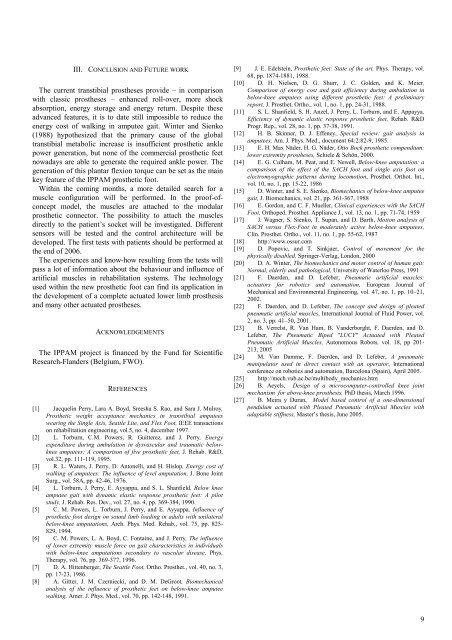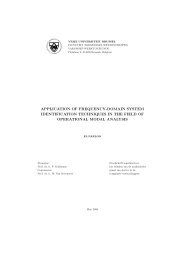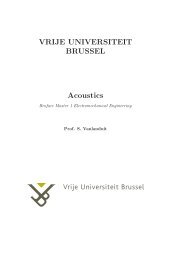IPPAM Intelligent Prosthesis actuated by pleated Pneumatic Artificial ...
IPPAM Intelligent Prosthesis actuated by pleated Pneumatic Artificial ...
IPPAM Intelligent Prosthesis actuated by pleated Pneumatic Artificial ...
- No tags were found...
You also want an ePaper? Increase the reach of your titles
YUMPU automatically turns print PDFs into web optimized ePapers that Google loves.
III. CONCLUSION AND FUTURE WORKThe current transtibial prostheses provide – in comparisonwith classic prostheses – enhanced roll-over, more shockabsorption, energy storage and energy return. Despite theseadvanced features, it is to date still impossible to reduce theenergy cost of walking in amputee gait. Winter and Sienko(1988) hypothesized that the primary cause of the globaltranstibial metabolic increase is insufficient prosthetic anklepower generation, but none of the commercial prosthetic feetnowadays are able to generate the required ankle power. Thegeneration of this plantar flexion torque can be set as the mainkey feature of the <strong>IPPAM</strong> prosthetic foot.Within the coming months, a more detailed search for amuscle configuration will be performed. In the proof-ofconceptmodel, the muscles are attached to the modularprosthetic connector. The possibility to attach the musclesdirectly to the patient’s socket will be investigated. Differentsensors will be tested and the control architecture will bedeveloped. The first tests with patients should be performed atthe end of 2006.The experiences and know-how resulting from the tests willpass a lot of information about the behaviour and influence ofartificial muscles in rehabilitation systems. The technologyused within the new prosthetic foot can find its application inthe development of a complete <strong>actuated</strong> lower limb prosthesisand many other <strong>actuated</strong> prostheses.ACKNOWLEDGEMENTSThe <strong>IPPAM</strong> project is financed <strong>by</strong> the Fund for ScientificResearch-Flanders (Belgium, FWO).REFERENCES[1] Jacquelin Perry, Lara A. Boyd, Sreesha S. Rao, and Sara J. Mulroy,Prosthetic weight acceptance mechanics in transtibial amputeeswearing the Single Axis, Seattle Lite, and Flex Foot, IEEE transactionson rehabilitation engineering, vol.5, no. 4, december 1997.[2] L. Torburn, C.M. Powers, R. Guitterez, and J. Perry, Energyexpenditure during ambulation in dysvascular and traumatic belowkneeamputees: A comparison of five prosthetic feet, J. Rehab. R&D,vol.32, pp. 111-119, 1995.[3] R. L. Waters, J. Perry, D. Antonelli, and H. Hislop, Energy cost ofwalking of amputees: The influence of level amputation, J. Bone JointSurg., vol. 58A, pp. 42-46, 1976.[4] L. Torburn, J. Perry, E. Ayyappa, and S. L. Shanfield, Below kneeamputee gait with dynamic elastic response prosthetic feet: A pilotstudy, J. Rehab. Res. Dev., vol. 27, no. 4, pp. 369-384, 1990.[5] C. M. Powers, L. Torburn, J. Perry, and E. Ayyappa, Influence ofprosthetic foot design on sound limb loading in adults with unilateralbelow-knee amputations, Arch. Phys. Med. Rehab., vol. 75, pp. 825-829, 1994.[6] C. M. Powers, L. A. Boyd, C. Fontaine, and J. Perry, The influenceof lower extremity muscle force on gait characteristics in individualswith below-knee amputations secondary to vascular disease, Phys.Therapy, vol. 76, pp. 369-377, 1996.[7] D. A. Hittenberger, The Seattle Foot, Ortho. Prosthet., vol. 40, no. 3,pp. 17-23, 1986.[8] A. Gitter, J. M. Czerniecki, and D. M. DeGroot, Biomechanicalanalysis of the influence of prosthetic feet on below-knee amputeewalking, Amer. J. Phys. Med., vol. 70, pp. 142-148, 1991.[9] J. E. Edelstein, Prosthetic feet: State of the art, Phys. Therapy, vol.68, pp. 1874-1881, 1988.[10] D. H. Nielsen, D. G. Shurr, J. C. Golden, and K. Meier,Comparison of energy cost and gait efficiency during ambulation inbelow-knee amputees using different prosthetic feet: A preliminaryreport, J. Prosthet. Ortho., vol. 1, no. 1, pp. 24-31, 1988.[11] S. L. Shanfield, S. H. Anzel, J. Perry, L. Torburn, and E. Appayya,Efficiency of dynamic elastic response prosthetic feet, Rehab. R&DProgr. Rep., vol. 28, no. 1, pp. 37-38, 1991.[12] H. B. Skinner, D. J. Effeney, Special review: gait analysis inamputees, Am. J. Phys. Med., document 64:2:82-9, 1985.[13] E. H. Max Näder, H. G. Näder, Otto Bock prosthetic compendium:lower extremity prostheses, Schiele & Schön, 2000.[14] E. G. Culham, M. Peat, and E. Newell, Below-knee amputation: acomparison of the effect of the SACH foot and single axis foot onelectromyographic patterns during locomotion, Prosthet. Orthot. Int.,vol. 10, no. 1, pp. 15-22, 1986[15] D. Winter, and S. E. Sienko, Biomechanics of below-knee amputeegait, J. Biomechanics, vol. 21, pp. 361-367, 1988[16] E. Gordon, and C. F. Mueller, Clinical experiences with the SACHFoot, Orthoped. Prosthet. Appliance J., vol. 13, no. 1, pp. 71-74, 1959[17] J. Wagner, S. Sienko, T. Supan, and D. Barth, Motion analysis ofSACH versus Flex-Foot in moderately active below-knee amputees,Clin. Prosthet. Ortho., vol. 11, no. 1, pp. 55-62, 1987[18] http://www.ossur.com[19] D. Popovic, and T. Sinkjaer, Control of movement for thephysically disabled, Springer-Verlag, London, 2000[20] D. A. Winter, The biomechanics and motor control of human gait:Normal, elderly and pathological, University of Waterloo Press, 1991[21] F. Daerden, and D. Lefeber, <strong>Pneumatic</strong> artificial muscles:actuators for robotics and automation, European Journal ofMechanical and Environmental Engineering, vol. 47, no. 1, pp. 10–21,2002.[22] F. Daerden, and D. Lefeber, The concept and design of <strong>pleated</strong>pneumatic artificial muscles, International Journal of Fluid Power, vol.2, no. 3, pp. 41–50, 2001.[23] B. Verrelst, R. Van Ham, B. Vanderborght, F. Daerden, and D.Lefeber, The <strong>Pneumatic</strong> Biped "LUCY" Actuated with Pleated<strong>Pneumatic</strong> <strong>Artificial</strong> Muscles, Autonomous Robots, vol. 18, pp 201-213, 2005[24] M. Van Damme, F. Daerden, and D. Lefeber, A pneumaticmanipulator used in direct contact with an operator, Internationalconference on robotics and automation, Barcelona (Spain), April 2005.[25] http://mech.vub.ac.be/multibody_mechanics.htm[26] B. Aeyels, Design of a microcomputer-controlled knee jointmechanism for above-knee prosthesis, PhD thesis, March 1996.[27] B. Meira y Duran, Model based control of a one-dimensionalpendulum <strong>actuated</strong> with Pleated <strong>Pneumatic</strong> <strong>Artificial</strong> Muscles withadaptable stiffness, Master’s thesis, June 2005.9
















